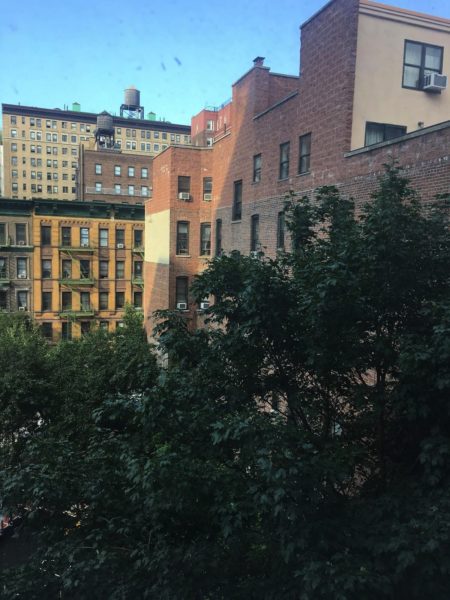
By Talia Winiarsky
About 40 years ago, Lydia Argote and her daughter, Liza, were taller than the newly planted trees behind their apartment building on West 108th Street between Broadway and Amsterdam Avenue. Eventually, two of the trees reached four stories high, providing shade for many residents of the building. When Liza grew older and visited from California, her children played in their shade, too.
Now, Argote and her daughter are once again taller than the trees. On a quiet Saturday morning, July 30, with no advance warning to the neighborhood, the trees became mere stumps after the city ordered them cut down.
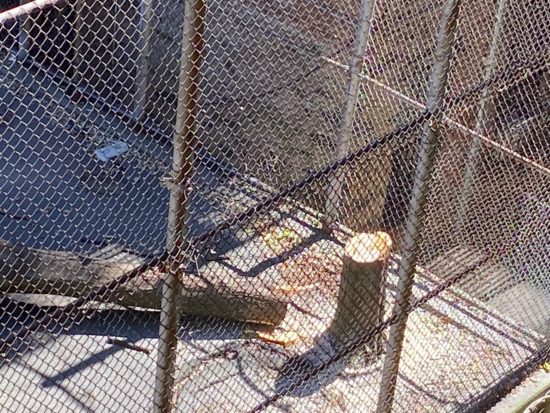
“We would have strapped ourselves to the trees to find out why,” said Argote, who only learned of the city’s plans as she saw the workers putting the finishing touches on the job. “That would have at least kept them alive for a little bit, but it was too late. They had already started to cut them down.”
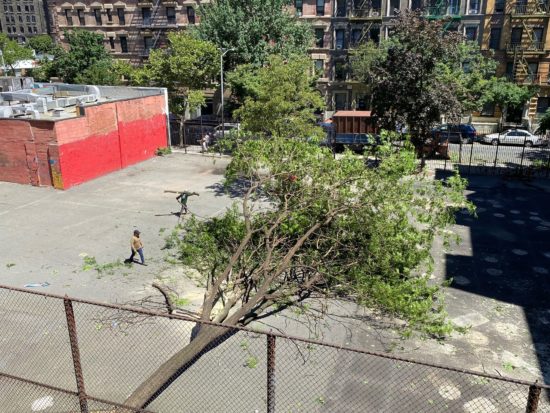
The tree removal is part of a Department of Education (DOE) renovation project on the playground at PS 165, an elementary school on West 109th Street, where the trees were planted, according to a department spokesperson. Three trees lined the back borders of the playground, and a fourth grew in its center.
Cutting down the trees will create room for “state-of-the-art blacktop asphalt flooring, tables and a comfortable seating area, play equipment, a full basketball court, and a track,” DOE explained, following an inquiry from the Rag a few weeks after the trees were cut down. The trees also needed to be removed because rodents burrowed in them, and their roots presented a tripping hazard, according to the department.
Nearby residents – some of whom said they had cherished the trees for decades – told the Rag that DOE did not inform the neighborhood of its plans or justifications in advance. Nor did they make it easy for residents to get answers once the trees were gone.
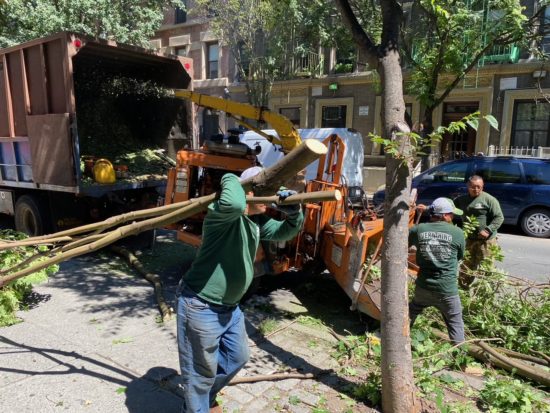
John Graham, a resident of one of the buildings that received shade from the trees, was on a Zoom call in his apartment that morning when he heard a sudden loud sound. He said he excused himself from the call to see what was happening and was devastated when he looked out his window to see the cut trees.
“We thought that the city valued trees for all of our lives, and the notion that it’d be cutting down healthy trees was just beyond belief,” Graham told the Rag.
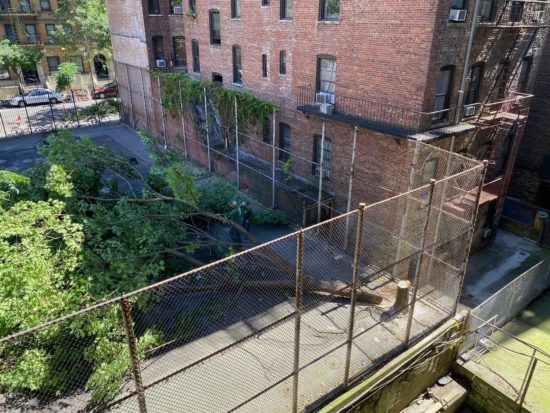
Tree canopies cover about 22 percent of the city, according to The New York Times, and various programs have sought to increase that number. In 2007, the city launched a MillionTreesNYC initiative with a goal to plant a million trees, which they achieved in 2015. Earlier this year, Manhattan Borough President Mark Levine proposed planting a million more trees by 2050.
The city’s Department of Parks & Recreation maintains a map that calculates the environmental benefits of each tree on city streets, including intercepting stormwater, removing carbon dioxide and other pollutants from the air, and conserving energy by shading buildings.
No work may be performed on or within 50 feet of a street tree without a permit from Parks & Recreation, their website says. However, the trees in the playground were not street trees, and were under the jurisdiction of DOE. It’s unclear whether that department needs permits from other city agencies to work on trees within a DOE-regulated area.
School administrators at PS 165 “were on-board after notification from project management,” a DOE spokesperson told the Rag. Neither the school’s principal nor its PTA responded to inquiries from the Rag.
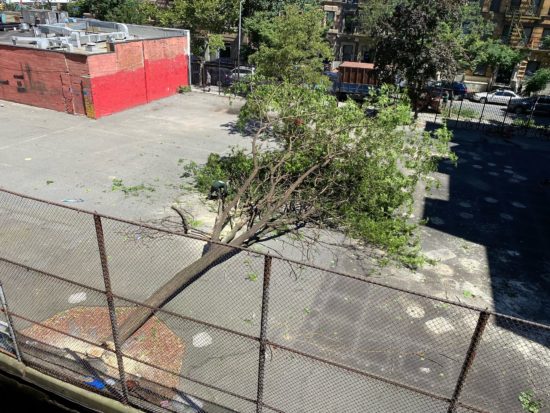
Regardless of who was responsible, the neighborhood should have been informed, said Graham. “Even though they may be on one property, like a schoolyard property, they’re valued by everybody in the neighborhood,” he said.
Nearby resident Chelsea Bassman said the action contradicted the city’s values. “We can’t seem to find the purpose, especially when the city wants to become greener,” she said, adding that the two largest trees — a maple and a locust — were native species particularly well suited to the local environment. These two trees were located at the border of the play area, and it was unclear to Bassman why they had to be removed to install a new playground, she said.
Some local residents said the trees were a home to many birds. Hearing them sing in an urban environment was a rare treat, and the trees may have sheltered some high-vulnerability species that live in the area, according to Audubon Society.
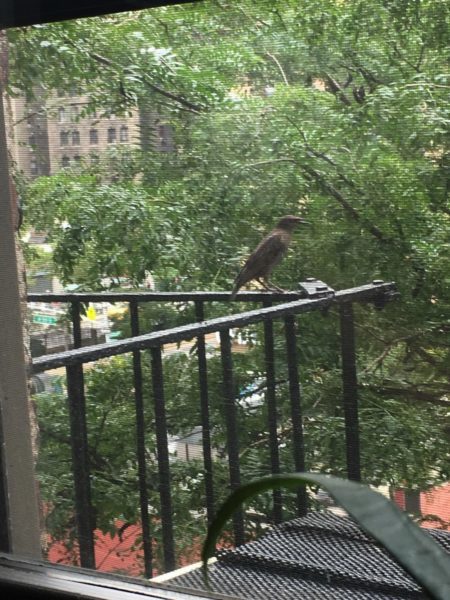
After the trees were cut down, Bassman said she and her husband pored over Community Board minutes, called the company that cut down the trees (which said only that it was doing a job for the city), and reached out to Shaun Abreu, the City Council representative for the neighborhood.
A spokesperson for Abreu, Emmitt Sklar, said Abreu’s office didn’t know about the plan in advance but will work to ensure that the city keeps the neighborhood informed going forward about the playground renovation plan, including how new trees might be incorporated into it.
“Making sure that our community has the trees and the foliage it needs to keep our landscape cool is really critical for the community, but also for our city as a whole as we’re trying to tackle the climate crisis,” Sklar said.
Planting new trees would be a good step forward, but no substitute for those that were cut down, said Bassman, who added that the loss of shade has made her apartment hotter this summer. “For the first time, my husband and I looked at each other like, ‘Wow, it’s hot in our apartment now.’ So we turned on our AC when we normally wouldn’t have,” she said.
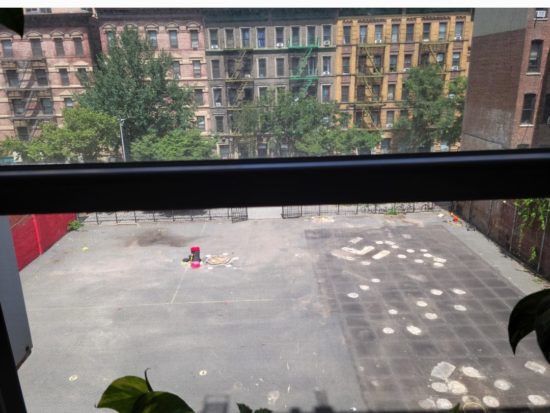
The city did eventually provide answers a few weeks later to those who doggedly pursued them. “The design decision was made to remove the trees due to existing root-patterns,” one local resident was told. “The trees were damaging and lifting up the original asphalt playground surface, causing a tripping/safety hazard. Allowing the trees to remain would have negatively impacted the new playground surface in the same manner, eventually becoming another safety-issue.”
The city also said the resurfacing of the playground will eliminate its current rodent problem. The school is in zip code 10025, which had the city’s largest number of 311 rat complaint calls at the end of last year.
For Argote, however, the removal is still devastating despite the explanation. If the tree roots truly posed a risk, she said, they would’ve been pulling up the asphalt years ago, as these trees had been around for several decades. “I felt they didn’t remove these trees — they killed them,” Argote said.
However, the incident and the neighbors’ collective advocacy illustrated their strong bond, Argote said. “I’m happy that I’m in a community that cares.”



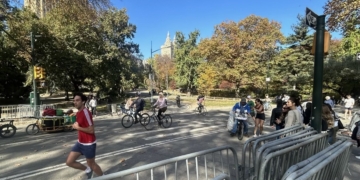





Re: “The tree removal is part of a Department of Education (DOE) renovation project on the playground at PS 165, ”
Ahh, yes…the folks at the DOE, whose unwritten motto is ‘We’re Not Happy Till You’re Not Happy’
haha! If we could make you more unhappy – we would. This is the least we could do.
With all due respect to the benefits of community involvement, I am beginning to wonder how in the world a city can possibly function if every decision has to be approved by every person affected by it ? How can anything ever get done in a timely way if every potential municipal action can be stalled, delayed, or debated into submission (as so many are these days) ?
The trees were lovely of course but the city must be allowed to weigh its options on a case-by-case basis – which they certainly seem to have done – and take action.
For someone to naysay that they ““can’t seem to find the purpose” is inexplicable when the purpose and the method are extremely clear. Sometimes public goals conflict and it’s the city’s job to make those choices.
I too would hate to lose the lovely cooling green the trees provided but this is life in the big city. Our apartment has a direct view of the playground and while it generates a LOT of VERY occasionally annoying noisy play we accept that it is a great benefit to a great number of kids. Everyone has to take one for the team.
Well said! A neighborhood as dense as the Upper West Side cannot exist if every single person has a veto over every single decision. We elect representatives to weigh the tradeoffs (shade vs a smooth playground surface) and make decisions. If you don’t like the choices made you can organize and try to elect new representatives. Demanding that you as an individual should get a personalized presentation and veto power over every decision made in the city isn’t democratic, it’s a recipe for paralysis and strangling the neighborhood to death.
Guys, who exactly is advocating that ” every single person has a veto over every single decision”?
Trees give life.
Idiots end the life trees give.
Of course they didn’t tell anyone in advance. People fetishize these trees and as a result nothing can happen. Everything is a controversy. You can plant more trees.
People fetishize pavement too because Americans worship cars.
There may be room for family or community involvement in the playground reno. Few spaces are more amenable to well planned shrubbery and shade giving trees – and maybe this time allowance can be made for deeper root development in a less obstructive direction. Swales to absorb and drain storm water and keep it from pooling on play and athletic areas etc benefit from and are beneficial to trees. There is a lot of expertise in the Parks department and I suspect some creative work with green playgrounds has been tried in various spots in the city. The school, PTA, and DoE have probably had to push for years to get any better playground space funded, planned, and underway. But now it will be interesting to see what the actual plans are. The elementary school on 10th Ave and 53rd (PS 111 Adolph Ochs) had a wonderful playground reno some years ago which brought trees and benches to a pretty bare space. My point (sorry so long) is that there may be opportunity to advocate for better community and school space, even as you mourn the four decades of shade and greenery that the old trees provided. With luck the school might welcome help/involvement (?)
To give credit where it is due: the Trust for Public Land is a leader in the area of green, sustainable playgrounds (designed with student and community input, in partnership with City Education and Parks Departments and other non profits). Info on the more than 200 playgrounds they have helped transform is here:
https://www.tpl.org/our-work/new-york-city-playgrounds
Hope such good planning and outcomes will come to the PS 165 space too!
Asphalt vs Trees. tough choice
You’re right, except in this case your statement is a bad generalization. It’s not simply trees vs. asphalt, there is a public playground involved. As the article says, the existing roots were lifting the playground surface, causing safety hazards which would continue to exist with the new surface….
Perhaps the better approach would be to work to see if new trees could be planted elsewhere on the property once the playground is finished.
Have noticed the past 4 years that the city has taken a “cut that thing down” approach to any tree seen blocking streetlight in a park, or trees that need trimming, or just trees anywhere within 20 feet of a construction project.
There are almost no arborists on staff for a city of almost 9 million. It’s OBSCENE & incredibly disrespectful to think that we need cops on horses (why?) rather than qualified professionals to look after the health of the urban forests
That’s not true, the parks department has plenty of arborists on staff. Every time there is a construction project that cuts down parks trees the parks department arborist comes up with a plan to replace them. They even have a formula for how many new trees equal one old tree.
So sad. Hopefully the school will plant some new trees when renovation is done. As a child, preferred trees and shade over any equipment.
“The city also said the resurfacing of the playground will eliminate its current rodent problem.”.
Brilliant idea; they could even extrapolate that brilliance: I bet if they leveled the whole city and covered the remains in a foot of hot asphalt the rat population would probably decline even further.
Note to the City: please don’t read the above extrapolation.
We don’t need to give them any ideas.
Worse on the his block is rodent infestation. Wheres the outcry over rats run amok all day and night?.
This is a terrible losss – murdered trees. Have them plant a bunch of new trees . Please.
“I think that I shall never see
A poem lovely as a tree…
..A tree that may in Summer wear
A nest of robins in her hair;…”
The way to knock down the rat population with any sizable impact is to stop the practice of putting out plastic garbage bags on the street. Plastic garbage bags on the streets at night are a joke. It’s scary just to walk past them the evening before trash pickup. Rats all over the place. Without all those plastic garbage bags everywhere (regularly scheduled rat buffets) fewer rats would be in the tree pits. This was an issue well before Covid brought outdoor dining sheds, but now? Rat dining plus rat shelter. When will the powers-that-be realize that plastic garbage bags are not exactly repelling sharp rat teeth?! How is it possible to discuss the rat problem in NYC when we keep feeding them? Beyond frustrating! How exactly is this the fault of trees? Sorry, too many words…
Killing rats is the new excuse for killing trees ?
We descend from arboreal creatures; we have trees deep in our psyche.
Whoever thought of the whole plastic-bags-for-rat-buffets wasn’t thinking, obviously, or they were thinking of replacing noisy steel cans so New Yorkers could sleep but NEW YORKERS DON’T SLEEP!
There’s way too much on our minds…
So bring back steel if there’s no other way to dissuade those endlessly gnawing creatures but WE NEED TREES more than they need us
because how else you gonna get rid of all the hurricane-forming, river-drying-up, wildfire-encouraging, ocean-rising, drought-&-crazily-enough-flooding-too CARBON that humans ABSOLUTELY INSIST on spewing absolutely everywhere, hmm?
Geez, they’re expanding a kids playground. And planting even more trees. were there before. And no, just bc you’re a neighbor, you don’t get veto power.
We talk to our kids about climate change and then one of the things that is proven to moderate air temperature, is cut down in favor of more asphalt. For me the real issue isn’t whether people in the neighborhood should or shouldn’t get veto power, the real question for me is why doesn’t the department of education value trees that took decades to grow and provide so many services? Could they not have put a raised platform under these trees? Do you think the kids will be so happy sitting out there in the baking sun on a hot day with no shade? Planting more, smaller trees can never replace the number of mature trees that they cut down. Not for decades.
Not to mention it’s just the opposite lesson on climate change that we might want to pass on to our kids. Shame on the department of education.